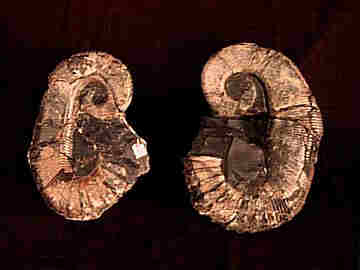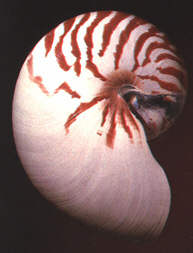|
Based on the similar appearance of their shells, ammonites probably
looked and behaved like modern nautiluses. The living nautilus has many
(38 or more) tentacles, with which it catches food. The nautilus has
small poorly developed eyes and a leather-like spotted hood. The
nautilus animal inhabits the last and largest chamber in its shell. The
animal grows new, larger chambers as it ages and grows bigger.
The shell of the nautilus protects the animal from predators. The
nautilus can withdraw completely into its shell, almost like a turtle,
and block the end of the shell with its hood. The nautilus uses the
empty chambers in its shell to help maintain neutral buoyancy. This
means the animal does not float or sink. The nautilus moves by "jet
propulsion," by blowing a stream of water out of a tube between its
shell. The nautilus lives in the open ocean near coral reefs. It is a
predator, eating shrimp and small fish.
|

Two "uncoiled" ammonites

A nautilus shell - notice the
smooth chamber walls
|